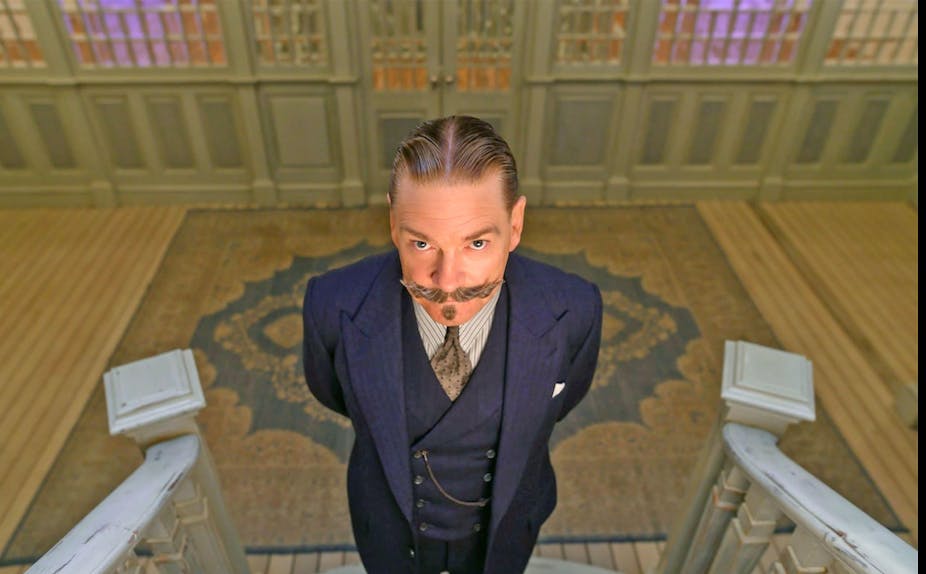Hercule Poirot, the Belgian detective with the flamboyant moustache and keen eye for detail, is one of the most beloved characters in crime fiction. He was created by British writer Agatha Christie and first arrived on our bookshelves in 1920. He has since appeared in 33 novels, 51 short stories and two plays.
He has also been depicted in film and television by an array of actors, with Kenneth Branagh’s latest iteration, A Haunting in Venice, opening on the big screen in September 2023.
Poirot’s characteristics have led us to speculate that he may be autistic, even though Christie never explicitly said so.
Headcanon and autistic representation
When audiences “headcanon” a character, this means they have interpreted them in a way which is not openly stated in the film, TV or other media in which they feature. As media portrayals of autistic people are rare and often unrealistic, the autistic and wider neurodivergent communities sometimes headcanon characters who aren’t explicitly confirmed as neurodivergent (ND).
However, creating a headcanon can cause controversy. They are subjective and some people believe the process of identifying a character as ND-coded is an over-simplification of the complexities of autism and other neurotypes. But celebrating difference can be positive for those who feel underrepresented in the media.
The detective
Detectives are often ND-coded in crime fiction stories. Their actions and diverse thought patterns are typically not understood by those around them. So, their personalities are labelled as “different”, or their mannerisms are classed as odd or eccentric.
Some are explicitly ND, such as Adrian Monk in the US series Monk and Saga Norén in the nordic noir series The Bridge. Others have been headcanoned as ND – most frequently, Sherlock Holmes in his various iterations.
Here are seven reasons why Hercule Poirot is also ND-coded:
1. Social exclusion
Poirot is regularly seen as “different” by those around him. Often, this is attributed to him being Belgian, with other characters drawing attention to his “odd” behaviours. He is also described as “positively exotic” in 1937’s Dumb Witness, and is regularly referred to as being French, something which angers Poirot.
2. Scripting
Poirot scripts conversations prior to having them, planning out what he will say and how he will act towards people, much like autistic people often do.
3. Masking
He also masks, which is a phenomenon frequently reported by autistic people, in which they hide or reduce elements of themselves to fit in. Poirot does this by putting on his “foreign shield of exaggerated mannerisms” – sometimes taking advantage of his uniqueness, knowing how others will see him and behaving accordingly.
4. Psychology
Poirot is interested in psychology, a common special interest for autistic people, who often wish to have an in-depth understanding of people.
He states that his brain and mind work differently to those around him, and arguably values his enduring companion Hastings for his “neurotypical” insights, telling him: “In you, Hastings, I find the normal mind almost perfectly illustrated.”

5. Interaction
Poirot also displays a unique interaction style which other characters often do not understand, or label peculiar. This mirrors the differences in communication preferences, and misunderstandings this can lead to, between neurotypical and ND people.
Poirot is less governed by social norms and customs, considering each character as an individual, regardless of their age, sex, gender or socioeconomic status. Christie often played on the readers’ prejudice, with the detective obliged to see beyond this.
For example, in Peril at End House (1932), Hastings believes that an affable sea commander must be above suspicion, but Poirot responds: “Doubtless he has been to what you consider the right school. Happily, being a foreigner, I am free from these prejudices, and can make investigations unhampered by them.”
6. Routine
Poirot is very particular in the way he solves crimes, through order and method. He enjoys keeping a routine, typically revolving around his meals, which he is also very particular about: “For my breakfast, I have only toast which is cut into neat little squares.”
Autistic people often find comfort in familiarity and in eating the same or safe foods.
7. Sensory regulation
Poirot wears tight, patent leather shoes, as described in Hallowe’en Party (1969): “He was unsuitably attired as to the feet in patent leather shoes which were, so Mr Fullerton guessed shrewdly, too tight for him.”
This habit is arguably for sensory reasons, which is very important for autistic people and their wellbeing.
Poirot requires a particular sensory environment to think properly, and values his alone time to process what he has learnt. He also likes to keep his immediate surroundings, including his friend Hastings, neat and orderly.
Although Poirot’s neurotype is never explicitly detailed in Christie’s works, fellow ND readers who understand and recognise these codes may headcanon Poirot as part of their community.

